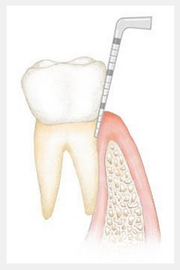|
By: Ashleigh Q: Are wiggly teeth normal? A: If you're a kid, yes. If you're an adult, no....and here is why: Periodontal disease (also known as gum disease) is an inflammatory disease that destroys the gums and other supporting tissues around teeth. The infection of those tissues is caused by a buildup of bacteria filled plaque. This is one reason why it is important not only to have great oral hygiene care at home, but also to visit a dentist at least twice a year under healthy circumstances, but more often if periodontal disease is active.  One of the first things your hygienist does is to check the health of your gums. He or she look to see if the are red and/or puffy and if they bleed easily. Then they check the pocket depth by using a tool called a probe. As you can see in the image to the left, this probing tool has lines on it. Each line equals 1 mm (millimeter). The probe slides gently between the side of the tooth and the gums to measure how well the bone and gum is attached to the root of tooth. You might hear us call these your "pocket depths."
Early Stages: If you notice that your gums are red, swollen, tender, bleed easily and/or have bad breath, you may have the early stages of gum disease call gingivitis. You are at a higher risk in developing gingivitis if you have poor dental care, smoke or chew tobacco, crooked teeth that are hard to clean, pregnancy, diabetes, or take certain medications. Genetics also can be a factor. Advance Stages: Warning signs include all those of gingivitis (red, swollen, tender, bleed easily and/or have bad breath), but also include gums that have pulled away from the teeth, and change of the way your teeth fit together when you bite. Gum disease is the major cause of tooth loss in adults. Increased pocket depths allow more bacteria to be trapped below the gumline that is more difficult to keep clean. This can cause the bone level to go down and the teeth are now less supported and they can become wiggly or loose. Treatment: If your hygienist and dentist diagnose you periodontal disease, he/she may recommend several options. Treatment options depend on the type of the disease and how far the condition has progressed. Here a few of the options that we offer patients.
Gum disease can be reversible and stabilized if found and treated during the early stages. A visit to your dentist for a thorough and professional cleaning is a great place to start as well as stepping up your home care. Brush twice a day for two minutes each and floss every day. Yes! Floss every day. Please visit MouthHealthy.org for more inoformation on periodontal disease and Gum Disease Myths. Images found on Pinterest.
1 Comment
Your comment will be posted after it is approved.
Leave a Reply. |
AuthorsAli Jones, D.D.S. - Dentist Archives
November 2021
|


 RSS Feed
RSS Feed

